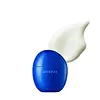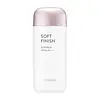What's inside
What's inside
 Key Ingredients
Key Ingredients

 Benefits
Benefits

 Concerns
Concerns

 Ingredients Side-by-side
Ingredients Side-by-side

Water
Skin ConditioningCyclomethicone
EmollientZinc Oxide
Cosmetic ColorantAlcohol Denat.
AntimicrobialEthylhexyl Methoxycinnamate
UV AbsorberC12-15 Alkyl Benzoate
AntimicrobialIsododecane
EmollientHdi/PPG/Polycaprolactone Crosspolymer
Tripropylene Glycol
AntioxidantDiethylamino Hydroxybenzoyl Hexyl Benzoate
UV FilterBis-Ethylhexyloxyphenol Methoxyphenyl Triazine
Skin ConditioningDierucic Acid
Skin ConditioningEctoin
Skin ConditioningGlycogen
HumectantGinkgo Biloba Leaf Extract
Skin ConditioningOryza Sativa Bran Extract
Skin ConditioningNelumbo Nucifera Flower Extract
Skin ConditioningCannabis Sativa Seed Extract
EmollientMorinda Citrifolia Fruit Extract
Skin ConditioningButylene Glycol
HumectantBHT
AntioxidantIsostearic Acid
CleansingGlycerin
HumectantSilica
AbrasiveSqualane
EmollientHydrogen Dimethicone
Parfum
MaskingWater, Cyclomethicone, Zinc Oxide, Alcohol Denat., Ethylhexyl Methoxycinnamate, C12-15 Alkyl Benzoate, Isododecane, Hdi/PPG/Polycaprolactone Crosspolymer, Tripropylene Glycol, Diethylamino Hydroxybenzoyl Hexyl Benzoate, Bis-Ethylhexyloxyphenol Methoxyphenyl Triazine, Dierucic Acid, Ectoin, Glycogen, Ginkgo Biloba Leaf Extract, Oryza Sativa Bran Extract, Nelumbo Nucifera Flower Extract, Cannabis Sativa Seed Extract, Morinda Citrifolia Fruit Extract, Butylene Glycol, BHT, Isostearic Acid, Glycerin, Silica, Squalane, Hydrogen Dimethicone, Parfum
Hydrolyzed Chestnut Extract
Skin ProtectingCyclopentasiloxane
EmollientSilica
AbrasiveZinc Oxide
Cosmetic ColorantDipropylene Glycol
HumectantLauryl PEG-10 Tris(Trimethylsiloxy)Silylethyl Dimethicone
EmulsifyingIsopropyl Palmitate
EmollientEthylhexyl Salicylate
UV AbsorberEthylhexyl Methoxycinnamate
UV AbsorberCaprylyl Methicone
Skin ConditioningTitanium Dioxide
Cosmetic ColorantAlcohol Denat.
AntimicrobialC12-15 Alkyl Benzoate
AntimicrobialAcrylates/Dimethicone Copolymer
Skin ConditioningVp/Hexadecene Copolymer
Limonia Acidissima Extract
Skin ConditioningOpuntia Ficus-Indica Extract
Skin ConditioningVerbena Officinalis Leaf Extract
MaskingAloe Barbadensis Leaf Extract
EmollientCinnamomum Cassia Bark Extract
MaskingPsidium Guajava Leaf Extract
AstringentRosa Rugosa Flower Extract
Skin ConditioningBiosaccharide Gum-4
Skin ConditioningBis-Ethylhexyloxyphenol Methoxyphenyl Triazine
Skin ConditioningMagnesium Sulfate
Dimethicone/Vinyl Dimethicone Crosspolymer
Skin ConditioningDimethicone
EmollientDiethylamino Hydroxybenzoyl Hexyl Benzoate
UV FilterQuaternium-18 Bentonite
Aluminum Hydroxide
EmollientStearic Acid
CleansingHydrogen Dimethicone
Water
Skin ConditioningSilica Dimethyl Silylate
EmollientSodium Benzoate
MaskingTocopheryl Acetate
AntioxidantPotassium Sorbate
PreservativePolyhydroxystearic Acid
EmulsifyingIsopropyl Myristate
EmollientIsostearic Acid
CleansingLecithin
EmollientEthylhexyl Palmitate
EmollientPolyglyceryl-3 Polyricinoleate
EmulsifyingDisodium EDTA
Phenoxyethanol
PreservativeCI 77491
Cosmetic ColorantCI 77492
Cosmetic ColorantHexyl Cinnamal
PerfumingBenzyl Salicylate
PerfumingHydrolyzed Chestnut Extract, Cyclopentasiloxane, Silica, Zinc Oxide, Dipropylene Glycol, Lauryl PEG-10 Tris(Trimethylsiloxy)Silylethyl Dimethicone, Isopropyl Palmitate, Ethylhexyl Salicylate, Ethylhexyl Methoxycinnamate, Caprylyl Methicone, Titanium Dioxide, Alcohol Denat., C12-15 Alkyl Benzoate, Acrylates/Dimethicone Copolymer, Vp/Hexadecene Copolymer, Limonia Acidissima Extract, Opuntia Ficus-Indica Extract, Verbena Officinalis Leaf Extract, Aloe Barbadensis Leaf Extract, Cinnamomum Cassia Bark Extract, Psidium Guajava Leaf Extract, Rosa Rugosa Flower Extract, Biosaccharide Gum-4, Bis-Ethylhexyloxyphenol Methoxyphenyl Triazine, Magnesium Sulfate, Dimethicone/Vinyl Dimethicone Crosspolymer, Dimethicone, Diethylamino Hydroxybenzoyl Hexyl Benzoate, Quaternium-18 Bentonite, Aluminum Hydroxide, Stearic Acid, Hydrogen Dimethicone, Water, Silica Dimethyl Silylate, Sodium Benzoate, Tocopheryl Acetate, Potassium Sorbate, Polyhydroxystearic Acid, Isopropyl Myristate, Isostearic Acid, Lecithin, Ethylhexyl Palmitate, Polyglyceryl-3 Polyricinoleate, Disodium EDTA, Phenoxyethanol, CI 77491, CI 77492, Hexyl Cinnamal, Benzyl Salicylate
 Reviews
Reviews

Ingredients Explained
These ingredients are found in both products.
Ingredients higher up in an ingredient list are typically present in a larger amount.
Alcohol Denat. is an alcohol with a denaturant property. It is created by mixing ethanol with other additives.
This ingredient gets a bad rep because it is irritating and drying - mostly due to its astringent property. Astringents draw out natural oils in tissue, constricting pores and leaving your skin dried out.
However, alcohol denat. is not all that bad.
Due to its low molecular weight, alcohol denat. tends to evaporate quickly. One study on pig skin found half of applied alcohol evaporated in 10 seconds and less than 3% stayed on skin.
This also helps other ingredients become better absorbed upon application.
Studies are conflicted about whether this ingredient causes skin dehydration. One study from 2005 found adding emollients to propanol-based sanitizer decreased skin dryness and irritation. Another study found irritation only occurs if your skin is already damaged.
Small amounts of alcohol are generally tolerated by oily skin or people who live in humid environments.
The rule of thumb is if this alcohol is near the end of an ingredients list, it will probably not affect your skin much.
Also...
This ingredient has antimicrobial and solvent properties.
The antimicrobial property helps preserve products and increase their shelf life. As a solvent, it helps dissolve other ingredients.
Other types of astringent alcohols include:
Learn more about Alcohol Denat.You might know this ingredient as Tinosorb S or Bemotrizinol. It is a UV filter that covers both UVA and UVB rays.
This ingredient has two peak UV absorption peaks ( 310 and 340 nm) and is able to absorb both UV-A and UV-B rays. This ingredient works by preventing UV rays from reaching and damaging your skin.
On top of that - it is highly photostable and helps prevent the photodegration of other sunscreen ingredients such as avobenzone.
Tinosorb S is allowed in the EU, Australia, and Asia. It is close to being approved by the FDA and we'll hopefully get this ingredient in the U.S. by late 2025.
Fun fact: Tinosorb S is the most effective UV absorber at maximum concentration (measured by SPF) permitted in the EU.
This ingredient is oil-soluble, so your oil-cleansers will take this right off at night.
Learn more about Bis-Ethylhexyloxyphenol Methoxyphenyl TriazineC12-15 Alkyl Benzoate is made up of Benzoic Acid and long chain alcohols. It has a low molecular weight.
C12-15 Alkyl Benzoate is an emollient and texture enhancer. Due to its solubility, it is often used in sunscreens to help evenly distribute active ingredients.
As an emollient, C12-15 Alkyl Benzoate helps soften and hydrate your skin. Emollients create a film on your skin that traps moisture within.
This ingredient has been reported to cause eye irritation.
Learn more about C12-15 Alkyl BenzoateDiethylamino Hydroxybenzoyl Hexyl Benzoate (DHHB) is a chemical UV-A absorber. It is formulated for high UVA protection (320-400 nm).
DHHB is well-liked for:
DHHB has been approved by the EU, Japan, Taiwan, and South America for use up to 10%. Unfortunately, it has not been approved for use in the US or Canada due to slow regulatory processes.
This ingredient is soluble in oils, fats, and lipids.
Learn more about Diethylamino Hydroxybenzoyl Hexyl BenzoateEthylhexyl Methoxycinnamate is an organic compound that provides UVB protection. It often goes by the more common name of octinoxate. It is created from methoxycinnamic acid and 2-ethylhexanol.
Ethylhexyl Methoxycinnamate absorbs UVB rays with wavelengths between 280-320 nm. UV absorbers protect your skin by using chemical reactions to convert UV rays into heat and energy.
UVB (290-320 nm) rays emit more energy than UVA rays. They are capable of damaging DNA, causing sunburns and are thought to be linked to skin cancer.
The state of Hawaii has banned sunscreens containing octinoxate due to its potential impact on coral reefs. More research is needed to bridge gaps in this research. The European Union allows higher levels of octinoxate in sunscreens than the US and Australia.
Ethylhexyl Methoxycinnamate is oil soluble. It is not stable and may lose efficacy when exposed to sunlight.
Learn more about Ethylhexyl MethoxycinnamateHydrogen Dimethicone is a type of silicone.
Isostearic acid is a saturated fatty acid. Its structure makes it a great surfactant.
Surfactants help decrease the surface tension between two liquids. This property also makes it an effective emulsifier. Emulsifiers help prevent waters and oils from separating in a product.
Isostearic Acid is created from oleic acid.
This ingredient may not be Malassezia folliculitis, or fungal-acne safe.
Learn more about Isostearic AcidSilica, also known as silicon dioxide, is a naturally occurring mineral. It is used as a fine, spherical, and porous powder in cosmetics.
Though it has exfoliant properties, the function of silica varies depending on the product.
The unique structure of silica enhances the spreadability and adds smoothness, making it a great texture enhancer.
It is also used as an active carrier, emulsifier, and mattifier due to its ability to absorb excess oil.
In some products, tiny microneedles called spicules are made from silica or hydrolyzed sponge. When you rub them in, they lightly polish away dead skin layers and enhance the penetration of active ingredients.
Learn more about SilicaWater. It's the most common cosmetic ingredient of all. You'll usually see it at the top of ingredient lists, meaning that it makes up the largest part of the product.
So why is it so popular? Water most often acts as a solvent - this means that it helps dissolve other ingredients into the formulation.
You'll also recognize water as that liquid we all need to stay alive. If you see this, drink a glass of water. Stay hydrated!
Learn more about WaterZinc Oxide is a mineral broad-spectrum UV filter; it is the broadest UVA and UVB reflector approved by the FDA. It also has skin protectant and skin soothing properties.
Zinc oxide is one of the most effective broad-spectrum UV filters. It protects against UVB, UVAII, and UVAI. In comparison to its counterpart titanium dioxide, zinc oxide provides uniform and extended UVA protection.
Another great benefit? This ingredient is highly photostable so it won't degrade easily under sunlight.
A common myth is that mineral UV filters are widely believed to primarily reflect UV light.
However, modern research shows titanium dioxide absorbs UV radiation like chemical filters (~95% absorption & 5% reflection).
Zinc oxide has great skin soothing properties so you'll likely find this in sunscreens formulated for sensitive skin or babies/children. It is unlikely to cause "eye sting" like other sunscreen ingredients.
Regulatory agencies consider zinc oxide to be non-toxic and safe. It has also been shown to not penetrate the skin.
Unfortunately, this ingredient does leave a visible white cast. This is why mineral sunscreens are often less cosmetically elegant than chemical or hybrid ones.
In cosmetics, zinc oxide can be found in both non-nano and nano-sized forms. The nano version is used to reduce white cast and improve the texture of sunscreen formulas.
There are ongoing concerns surrounding nano-zinc oxide's impact on marine ecosystems and whether it can be absorbed into skin.
Regarding marine ecosystems and coral reefs, there is no conclusive evidence that any form of zinc oxide (or any other sunscreen ingredients) will cause harm. The science is still developing but many consumers are keeping a close eye on this issue.
Please note, many destinations have reef-safety sunscreen rules. For instance, the U.S. Virgin Islands advises all visitors to use non-nano mineral sunscreens.
There has also been some stir about whether micronized or nano zinc oxide has potential photoxicity and absorption through the skin/lungs.
An in-vitro (done in a test tube or petri dish) study demonstrated micronized zinc oxide to have potential phototoxicity. There's no need to fret; the EU Commission's Scientific Committee on Consumer Safety has stated, "The relevance of these findings needs to be clarified by appropriate investigations in vivo." Or in other words, further studies done on living organisms are needed to prove this.
Current research shows zinc oxide nanoparticles do not penetrate intact or sunburned skin. They either remain on the surface or in the outermost layer of dead skin (stratum corneum).
Zinc oxide is one of only two classified mineral UV filters with titanium dioxide being the other one.
Fun fact: Zinc has been used throughout history as an ingredient in paint and medicine. An Indian text from 500BC is believed to list zinc oxide as a salve for open wound. The Ancient Greek physician Dioscorides has also mentioned the use of zinc as an ointment in 1AD.
Learn more about Zinc Oxide